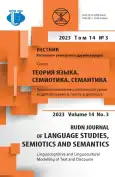Functional and Semantic Dominants of the Digital Transmedia Language in the Context of Topical Problems of Intercultural Communication
- Авторлар: Paracchini L.1, Trofimova G.N.2
-
Мекемелер:
- Milan State University
- RUDN University
- Шығарылым: Том 14, № 3 (2023): LINGUOCOGNITIVE AND LINGUOCULTURAL MODELLING OF TEXT AND DISCOURSE
- Беттер: 757-768
- Бөлім: SEMANTICS AND SEMIOTICS
- URL: https://journal-vniispk.ru/2313-2299/article/view/323416
- DOI: https://doi.org/10.22363/2313-2299-2023-14-3-757-768
- EDN: https://elibrary.ru/RAIRAG
- ID: 323416
Дәйексөз келтіру
Толық мәтін
Аннотация
The study is devoted to the identification and systematization within the thematic framework of some key functional and semantic characteristics of the landscape of modern transmedia, a multi-format media space consisting of thematically interconnected media resources reflecting a single event in the fields of online media, social network аnd new media. Having examined examples of special social significance (pandemics) events in Russian and Italian transmedia, the authors come to the conclusion that the language of digital transmedia demonstrates trends of universalization, which contributes to reducing information risks and weakening threats of information confrontation, despite the differences in the functioning of the language systems.
Негізгі сөздер
Авторлар туралы
Laila Paracchini
Milan State University
Email: laila.paracchini@unimi.it
ORCID iD: 0000-0002-4053-247X
PhD in Philology, Chief Researcher
Festa del Perdono str., 7, Milan, Italy, 20122Galina Trofimova
RUDN University
Хат алмасуға жауапты Автор.
Email: trofimova-gn@rudn.ru
ORCID iD: 0000-0002-1295-5002
D.Sc. in Philology, Professor of the Department of Mass Communication, Philological Faculty
6, Miklukho-Maklaya Str, Moscow, Russian Federation, 117198Әдебиет тізімі
- Dobrosklonskaya, T.G. (2005). Issues in the study of media texts (experience in researching modern English media speech). Moscow: Editorial URSS. (In Russ.).
- Jenkins, H. (2004). The Cultural Logic of Media Convergence. International Journal of Cultural Studies, 7 (1), 34–35.
- Jenkins, H. (2006). Convergence culture: Where old and new media collide. N.-Y.: New York University Press.
- Scolari, C.A. (2009). Transmedia Storytelling: Implicit Consumers, Narrative Worlds and Branding in Contemporary Media Production. International Journal of Communication, 3, 586–606.
- Gambarato, R.R. (2017). Panorama of Russian transmedia: experience of mapping multiplatform initiatives. Steps, 2, 20–46. (In Russ.).
- Jansson, A. (2013). Mediatization and social space: Reconstructing mediatization for the transmedia age. Communication Theory, 23, 279–296.
- Sokolova, N.L. (2011). Transmedia and “interpretive communities”. International Journal of Cultural Research, 3, 16–21. (In Russ.).
- Kalinov, K. (2017). Transmedia Narratives: Definition and Social Transformations in the Consumption of Media Content in the Globalized World. Postmodernism problems, 1, 60–68.
- Pratten, R. (2011). Getting Started in Transmedia Storytelling: A Practical Guide for Beginners. Seattle: Create Space. pp. 13–15.
- Kalmykov, A.A. & Kokhanova, L.A. (2001). Internet journalism. Moscow: Unity-Dana Publ. (In Russ.).
- Krasnoyarova, O.V. (2015). New Terms in the Mass Communication Theory: Processes of Formation and Principles of Functioning. Theoretical and Practical Issues of Journalism, 3, 229–238. https://doi.org/10.17150/2308-6203.2015.4 (3).229-238 (In Russ.).
- Deminova, M.A. & Kharkova, D.V. (2020). Definition of Transmedia Text. Media Research, 7, 96–103. (In Russ.).
- Dictionary of the Russian language of the coronavirus era (2021). Priemysheva, M.N. (Ed.), Institute of Linguistic Research. St. Petersburg: RAS. (In Russ.).
- Cornaglia Ferraris, P. (2020). COVID-19. Piccolo dizionario di ció che sappiamo. Laterza: Rome-Bari.
- De Vecchis, K. (2021). Long Covid e sindrome post-Covid: nuove parole dalla pandemia. Italiano digitale, XVIII (3), 102–107.
- Paoli, M. (2020). L’italiano e uscito dal lockdown. Italiano digitale, XIII (2), 108–121.
- New words and dictionaries of new words (2020). Kozlovskaya, N.V. (Ed.). St. Petersburg: ILI RAS. pp. 148–190. (In Russ.).
Қосымша файлдар









